Climate Change Impacts on Water and Agriculture Sectors in Southern Africa: Threats and Opportunities for Sustainable Development
Abstract
1. Introduction
2. Overview of Water and Agriculture Sectors in Southern Africa
3. Changes in Climatic Variables in Southern Africa
3.1. Changes in Climatic Variables (Temperature and Rainfall)
3.2. Changes in Rainfall, Aridity, and Water Scarcity in Southern Africa
3.3. Intensity and Frequency of Droughts and Floods
4. Implications of Water and Food Insecurity on Sustainable Development
5. Adaptation Options and Achieving Sustainable Development Outcomes
6. Conclusions
Author Contributions
Funding
Acknowledgments
Conflicts of Interest
References
- Ahlenius, H.; UNEP/GRID-Arendal. The Environmental Food Crisis—The Environment’s Role in Averting Future Food Crises; UNEP/GRID-Arendal: Arendal, Norway, 2009.
- Niang, I.; Ruppel, O.; Abdrabo, M.; Essel, A.; Lennard, C.; Padgham, J.; Urquhart, P. Africa. In Climate Change 2014: Impacts, Adaptation, and Vulnerability. Part B: Regional Aspects. Contribution of Working Group II to the Fifth Assessment Report of the Intergovernmental Panel on Climate Change; Barros, V., Field, C., Dokken, D., Mastrandrea, M., Mach, K., Bilir, T., Chatterjee, M., Ebi, K., Estrada, Y., Genova, R., et al., Eds.; Cambridge University Press: Cambridge, UK; New York, NY, USA, 2014; pp. 1199–1265. [Google Scholar]
- AUC. Malabo Declaration on Accelerated Agricultural Growth and Transformation for Shared Prosperity and Improved Livelihoods; African Union Commission: Addis Ababa, Ethiopia, 2014. [Google Scholar]
- Chemnitz, C.; Hoeffler, H. Adapting African agriculture to climate change. Int. J. Rural. Dev. 2011, 45, 32–35. [Google Scholar]
- Faramarzi, M.; Abbaspour, K.C.; Vaghefi, S.A.; Farzaneh, M.R.; Zehnder, A.J.; Srinivasan, R.; Yang, H. Modeling impacts of climate change on freshwater availability in Africa. J. Hydrol. 2013, 480, 85–101. [Google Scholar] [CrossRef]
- Hope, K.R. Climate change and poverty in Africa. Int. J. Sustain. Dev. World Ecol. 2009, 16, 451–461. [Google Scholar] [CrossRef]
- Guha-Sapir, D.; Below, R.; Hoyois, P. The International Disaster Database. Centre for Research on the Epidemiology of Disasters (CRED); Université Catholique de Louvain: Brussels, Belgium, 2020. [Google Scholar]
- Wheeler, T.; Von Braun, J. Climate change impacts on global food security. Science 2013, 341, 508–513. [Google Scholar] [CrossRef] [PubMed]
- Olmstead, S.M. Climate change adaptation and water resource management: A review of the literature. Energy Econ. 2014, 46, 500–509. [Google Scholar] [CrossRef]
- Arnell, N.W.; van Vuuren, D.P.; Isaac, M. The implications of climate policy for the impacts of climate change on global water resources. Glob. Environ. Chang. 2011, 21, 592–603. [Google Scholar] [CrossRef]
- Rosenzweig, C.; Elliott, J.; Deryng, D.; Ruane, A.C.; Müller, C.; Arneth, A.; Boote, K.J.; Folberth, C.; Glotter, M.; Khabarov, N. Assessing agricultural risks of climate change in the 21st century in a global gridded crop model intercomparison. Proc. Natl. Acad. Sci. USA 2014, 111, 3268–3273. [Google Scholar] [CrossRef] [PubMed]
- Hall, J.W.; Grey, D.; Garrick, D.; Fung, F.; Brown, C.; Dadson, S.J.; Sadoff, C.W. Coping with the curse of freshwater variability. Science 2014, 346, 429–430. [Google Scholar] [CrossRef] [PubMed]
- Nhamo, L.; Mabhaudhi, T.; Modi, A. Preparedness or repeated short-term relief aid? Building drought resilience through early warning in southern Africa. Water SA 2019, 45, 75–85. [Google Scholar] [CrossRef]
- Stevanović, M.; Popp, A.; Lotze-Campen, H.; Dietrich, J.P.; Müller, C.; Bonsch, M.; Schmitz, C.; Bodirsky, B.L.; Humpenöder, F.; Weindl, I. The impact of high-end climate change on agricultural welfare. Sci. Adv. 2016, 2, e1501452. [Google Scholar] [CrossRef]
- Moore, F.C.; Baldos, U.L.C.; Hertel, T. Economic impacts of climate change on agriculture: A comparison of process-based and statistical yield models. Environ. Res. Lett. 2017, 12, 065008. [Google Scholar]
- Schlenker, W.; Lobell, D.B. Robust negative impacts of climate change on African agriculture. Environ. Res. Lett. 2010, 5, 014010. [Google Scholar]
- Kurukulasuriya, P.; Mendelsohn, R.; Hassan, R.; Benhin, J.; Deressa, T.; Diop, M.; Eid, H.M.; Fosu, K.Y.; Gbetibouo, G.; Jain, S. Will African agriculture survive climate change? World Bank Econ. Rev. 2006, 20, 367–388. [Google Scholar]
- Nhemachena, C.; Hassan, R.; Kurukulasuriya, P. Measuring the economic impact of climate change on African agricultural production systems. Clim. Chang. Econ. 2010, 1, 33–55. [Google Scholar]
- Knox, J.; Hess, T.; Daccache, A.; Wheeler, T. Climate change impacts on crop productivity in Africa and South Asia. Environ. Res. Lett. 2012, 7, 034032. [Google Scholar]
- Rockstrom, J. Water resources management in smallholder farms in Eastern and Southern Africa: An overview. Phys. Chem. Earth Part B Hydrol. Ocean. Atmos. 2000, 25, 275–283. [Google Scholar]
- Nhamo, L.; Matchaya, G.; Mabhaudhi, T.; Nhlengethwa, S.; Nhemachena, C.; Mpandeli, S. Cereal production trends under climate change: Impacts and adaptation strategies in southern Africa. Agriculture 2019, 9, 30. [Google Scholar]
- Nicholson, S.E.; Funk, C.; Fink, A.H. Rainfall over the African continent from the 19th through the 21st century. Glob. Planet. Chang. 2018, 165, 114–127. [Google Scholar]
- Nyagwambo, N.; Chonguiça, E.; Cox, D.; Monggae, F. Local Governments and IWRM in the SADC Region. LoGo Water Report; Institute for Water and Sanitation (IWS): Harare, Zimbabwe, 2008. [Google Scholar]
- Nhamo, L. Trends and Outlook: Agricultural Water Management in Southern Africa, SADC AgWater Profiles. Project Report Submitted to United States Agency for International Development’s (USAID’s) Feed the Future Program; International Water Management Institute: Pretoria, South Africa, 2015. [Google Scholar]
- Nhamo, L.; Ndlela, B.; Nhemachena, C.; Mabhaudhi, T.; Mpandeli, S.; Matchaya, G. The water-energy-food nexus: Climate risks and opportunities in southern Africa. Water 2018, 10, 567. [Google Scholar]
- IWMI. Irrigated Area Map of Asia (2000–2010) and Africa (2010); International Water Management Instsitute (IWMI): Colombo, Sri Lanka, 2015. [Google Scholar]
- Southern Africa Development Community. Regional Agricultural Policy; SADC: Gaborone, Botswana, 2014.
- Nhemachena, C.; Matchaya, G.; Nhemachena, C.R.; Karuaihe, S.; Muchara, B.; Nhlengethwa, S. Measuring Baseline Agriculture-Related Sustainable Development Goals Index for Southern Africa. Sustainability 2018, 10, 849. [Google Scholar]
- Southern Africa Development Community. Revised Regional Indicative Strategic Development Plan 2015–2020; Southern Africa Development Community (SADC): Gaborone, Botswana, 2015.
- Holloway, A. Drought emergency, yes. drought disaster, no: Southern Africa 1991–1993. Camb. Rev. Int. Aff. 2000, 14, 254–276. [Google Scholar]
- SADC. SADC Regional Humanitarian Appeal, June 2016; Southern Africa Development Community (SADC): Gaborone, Botswana, 2016.
- Davis, C. Climate Risk and Vulnerability: A Handbook for Southern Africa; Council for Scientific and Industrial Research (CSIR): Pretoria, South Africa, 2011. [Google Scholar]
- Vörösmarty, C.J.; Douglas, E.M.; Green, P.A.; Revenga, C. Geospatial indicators of emerging water stress: An application to Africa. AMBIO J. Hum. Environ. 2005, 34, 230–236. [Google Scholar] [CrossRef]
- Malisawa, M.; Rautenbach, C.d.W. Evaluating water scarcity in the Southern African Development Community (SADC) region by using a climate moisture index (CMI) indicator. Water Sci. Technol. Water Supply 2012, 12, 45–55. [Google Scholar]
- Boko, M.; Niang, I.; Nyong, A.; Vogel, C.; Githeko, A.; Medany, M.; Osman-Elasha, B.; Tabo, R.; Yanda, P. Africa. In Climate Change 2007: Impacts, Adaptation and Vulnerability. Contribution of Working Group II to the Fourth Assessment Report of the Intergovernmental Panel on Climate Change; Parry, M., Canziani, O., Palutikof, J., van der Linden, P., Hanson, C., Eds.; Cambridge University Press: Cambridge, UK, 2007; pp. 433–467. [Google Scholar]
- Tadross, M.; Suarez, P.; Lotsch, A.; Hachigonta, S.; Mdoka, M.; Unganai, L.; Lucio, F.; Kamdonyo, D.; Muchinda, M. Growing-season rainfall and scenarios of future change in southeast Africa: Implications for cultivating maize. Clim. Res. 2009, 40, 147–161. [Google Scholar] [CrossRef]
- Abell, R.; Vigerstol, K.; Higgins, J.; Kang, S.; Karres, N.; Lehner, B.; Sridhar, A.; Chapin, E. Freshwater biodiversity conservation through source water protection: Quantifying the potential and addressing the challenges. Aquat. Conserv. Mar. Freshw. Ecosyst. 2019, 29, 1022–1038. [Google Scholar]
- Davis, C.L.; Vincent, K. Climate Risk and Vulnerability: A Handbook for Southern Africa, 2nd ed.; Council for Scientific and Industrial Research (CSIR): Pretoria, South Africa, 2017; p. 202. [Google Scholar]
- IPCC. Climate Change 2014: Synthesis Report. Contribution of Working Groups I, II and III to the Fifth Assessment Report of the Intergovernmental Panel on Climate Change; Core Writing Team, Pachauri, R.K., Meyer, L.A., Eds.; Intergovernmental Panel on Climate Change (IPCC): Geneva, Switzerland, 2014; p. 151.
- Ward, P.J.; Eisner, S.; Flörke, M.; Dettinger, M.D.; Kummu, M. Annual flood sensitivities to El Niño-Southern Oscillation at the global scale. Hydrol. Earth Syst. Sci. 2014, 18, 47–66. [Google Scholar]
- Garnett, T.; Appleby, M.C.; Balmford, A.; Bateman, I.J.; Benton, T.G.; Bloomer, P.; Burlingame, B.; Dawkins, M.; Dolan, L.; Fraser, D. Sustainable intensification in agriculture: Premises and policies. Science 2013, 341, 33–34. [Google Scholar]
- Wada, Y.; Bierkens, M.F. Sustainability of global water use: Past reconstruction and future projections. Environ. Res. Lett. 2014, 9, 104003. [Google Scholar] [CrossRef]
- Challinor, A.; Wheeler, T.; Garforth, C.; Craufurd, P.; Kassam, A. Assessing the vulnerability of food crop systems in Africa to climate change. Clim. Chang. 2007, 83, 381–399. [Google Scholar]
- FAO. Adaptation to Climate Change in Agriculture, Forestry and Fisheries: Perspective, Framework and Priorities; Food and Agriculture Organization of the United Nations (FAO): Rome, Italy, 2007.
- Nhemachena, C.; Matchaya, G.; Nhlengethwa, S.; Nhemachena, C.R. Economic Aspects of Genetic Resources in Addressing Agricultural Productivity in the Context of Climate Change. In Climate Change and Multi-Dimensional Sustainability in African Agriculture; Springer International Publishing: New York, NY, USA, 2016; pp. 171–183. [Google Scholar]
- Lobell, D.B.; Burke, M.B.; Tebaldi, C.; Mastrandrea, M.D.; Falcon, W.P.; Naylor, R.L. Prioritizing climate change adaptation needs for food security in 2030. Science 2008, 319, 607–610. [Google Scholar] [CrossRef]
- Nhamo, L.; Matchaya, G.; Nhemachena, C.; van Koppen, B. The impact of investment in smallholder irrigation schemes on irrigation expansion and crop productivity in Malawi. Afr. J. Agric. Resour. Econ. 2016, 11, 141–153. [Google Scholar]
- Hassan, R.; Nhemachena, C. Determinants of African farmers’ strategies for adapting to climate change: Multinomial choice analysis. Afr. J. Agric. Resour. Econ. 2008, 2, 83–104. [Google Scholar]
- Dile, Y.T.; Karlberg, L.; Temesgen, M.; Rockström, J. The role of water harvesting to achieve sustainable agricultural intensification and resilience against water related shocks in sub-Saharan Africa. Agric. Ecosyst. Environ. 2013, 181, 69–79. [Google Scholar] [CrossRef]
- Jägermeyr, J.; Gerten, D.; Heinke, J.; Schaphoff, S.; Kummu, M.; Lucht, W. Water savings potentials of irrigation systems: Global simulation of processes and linkages. Hydrol. Earth Syst. Sci. 2015, 19, 3073. [Google Scholar] [CrossRef]
- Jägermeyr, J.; Gerten, D.; Schaphoff, S.; Heinke, J.; Lucht, W.; Rockström, J. Integrated crop water management might sustainably halve the global food gap. Environ. Res. Lett. 2016, 11, 025002. [Google Scholar] [CrossRef]
- De Fraiture, C.; Wichelns, D. Satisfying future water demands for agriculture. Agric. Water Manag. 2010, 97, 502–511. [Google Scholar] [CrossRef]
- Cosgrove, W.J.; Loucks, D.P. Water management: Current and future challenges and research directions. Water Resour. Res. 2015, 51, 4823–4839. [Google Scholar] [CrossRef]
- Tripathi, L.; Ntui, V.O.; Tripathi, J.N. Application of genetic modification and genome editing for developing climate-smart banana. Food Energy Secur. 2019, 8, e00168. [Google Scholar] [CrossRef]
- Batista-Silva, W.; da Fonseca-Pereira, P.; Martins, A.O.; Zsögön, A.; Nunes-Nesi, A.; Araújo, W.L. Engineering Improved Photosynthesis in the Era of Synthetic Biology. Plant Commun. 2020, 1, 100032. [Google Scholar] [CrossRef]
- Nhamo, L.; Magidi, J.; Nyamugama, A.; Clulow, A.D.; Sibanda, M.; Chimonyo, V.G.P.; Mabhaudhi, T. Prospects of Improving Agricultural and Water Productivity through Unmanned Aerial Vehicles. Agriculture 2020, 10, 256. [Google Scholar] [CrossRef]
- Wolfert, S.; Ge, L.; Verdouw, C.; Bogaardt, M.-J. Big data in smart farming—A review. Agric. Syst. 2017, 153, 69–80. [Google Scholar] [CrossRef]
- Lunt, T.; Jones, A.W.; Mulhern, W.S.; Lezaks, D.P.; Jahn, M.M. Vulnerabilities to agricultural production shocks: An extreme, plausible scenario for assessment of risk for the insurance sector. Clim. Risk Manag. 2016, 13, 1–9. [Google Scholar] [CrossRef]
- Chou, T.-Y.; Yeh, M.-L.; Chen, Y.C.; Chen, Y.H. Disaster monitoring and management by the Unmanned Aerial Vehicle technology. In Proceedings of the ISPRS TC VII Symposium—100 Years ISPRS, Vienna, Austria, 5–7 July 2010. [Google Scholar]
- Greatrex, H.; Hansen, J.; Garvin, S.; Diro, R.; Le Guen, M.; Blakeley, S.; Rao, K.; Osgood, D. Scaling Up Index Insurance for Smallholder Farmers: Recent Evidence and Insights, 1904–9005; CGIAR Research Program on Climate Change, Agriculture and Food Security (CCAFS): Copenhagen, Denmark, 2015; p. 32. [Google Scholar]
- Bryan, E.; Deressa, T.T.; Gbetibouo, G.A.; Ringler, C. Adaptation to climate change in Ethiopia and South Africa: Options and constraints. Environ. Sci. Policy 2009, 12, 413–426. [Google Scholar] [CrossRef]
- Chavas, J.-P.; Di Falco, S.; Adinolfi, F.; Capitanio, F. Weather effects and their long-term impact on the distribution of agricultural yields: Evidence from Italy. Eur. Rev. Agric. Econ. 2019, 46, 29–51. [Google Scholar] [CrossRef]
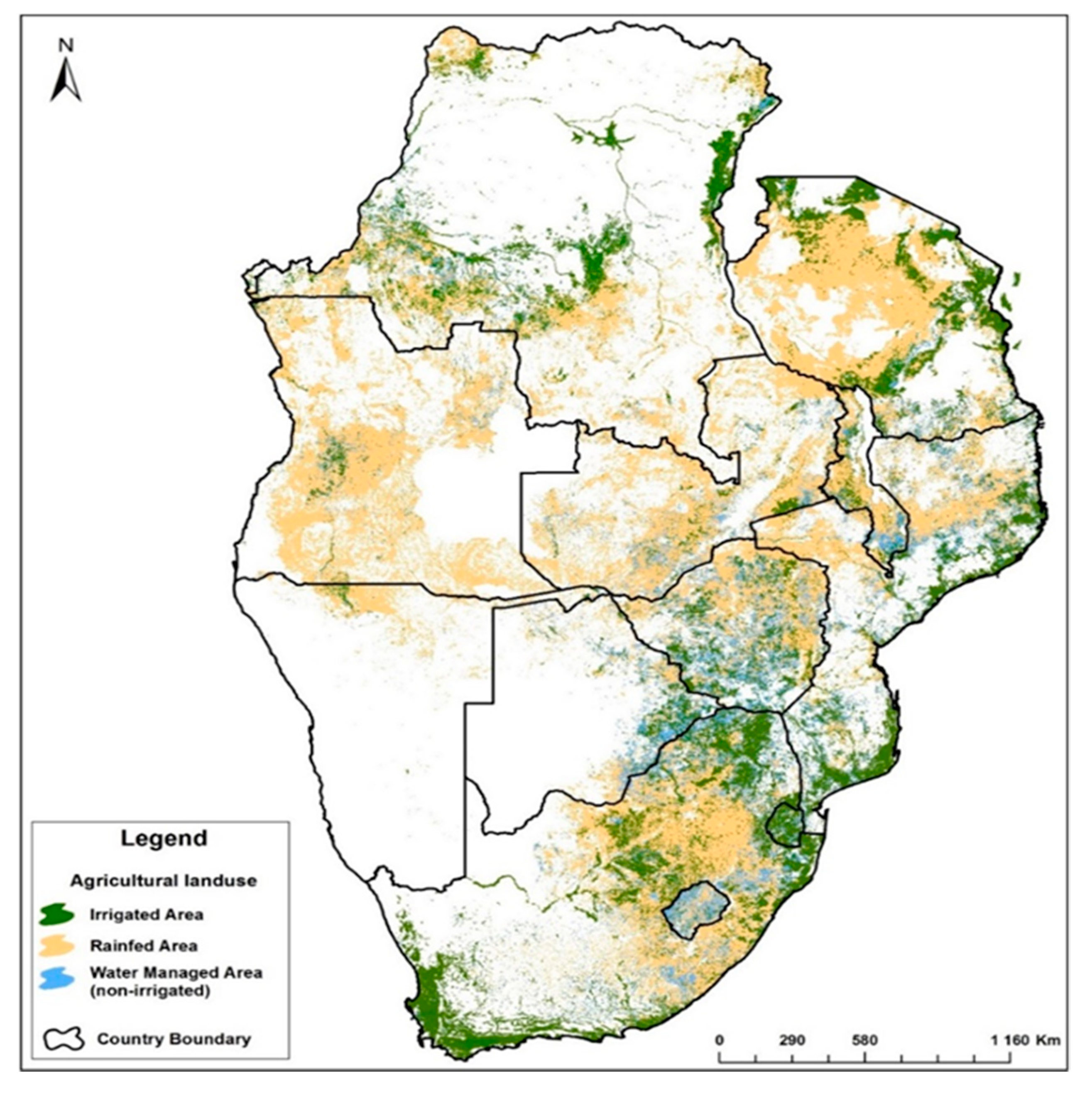
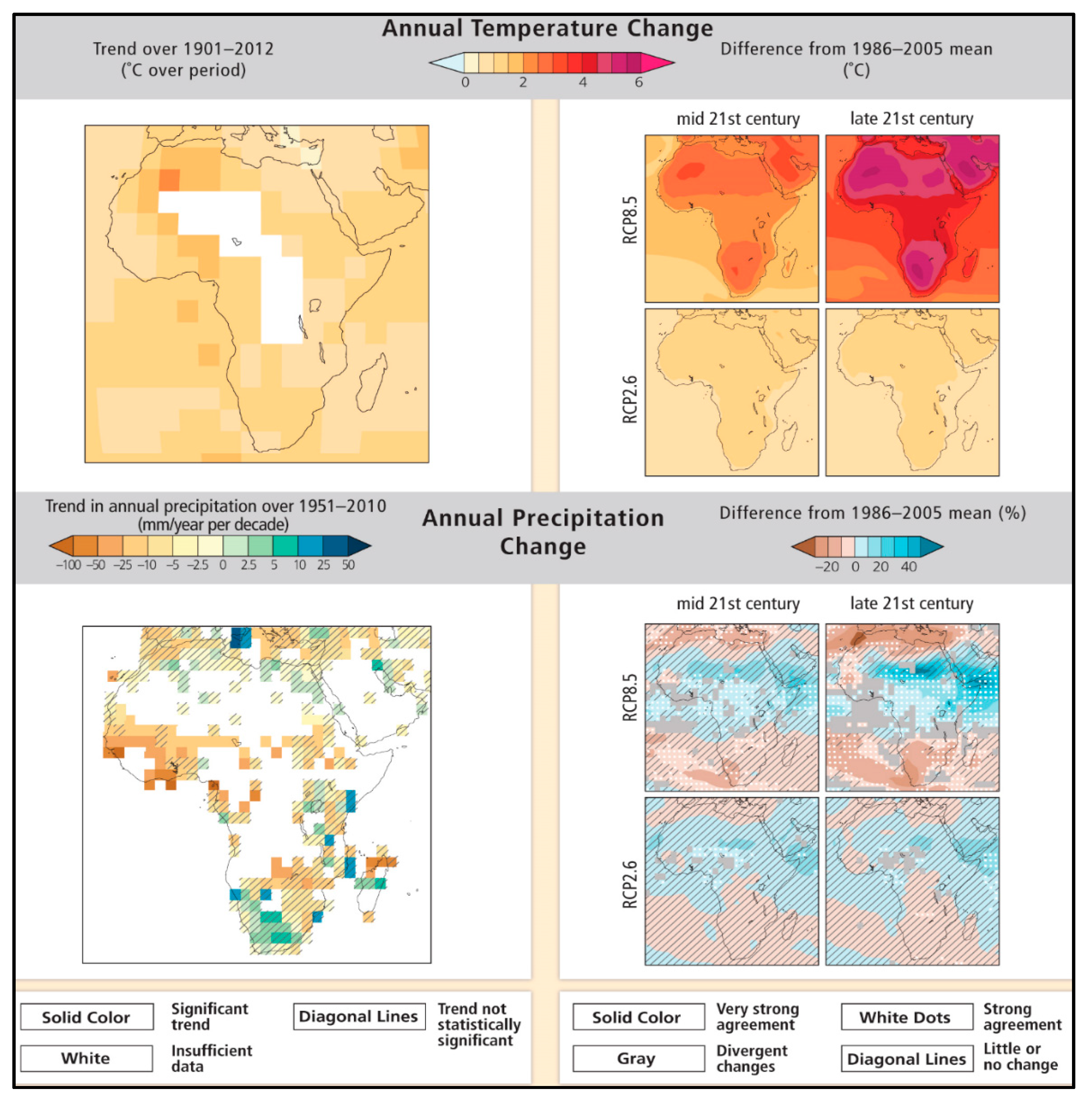
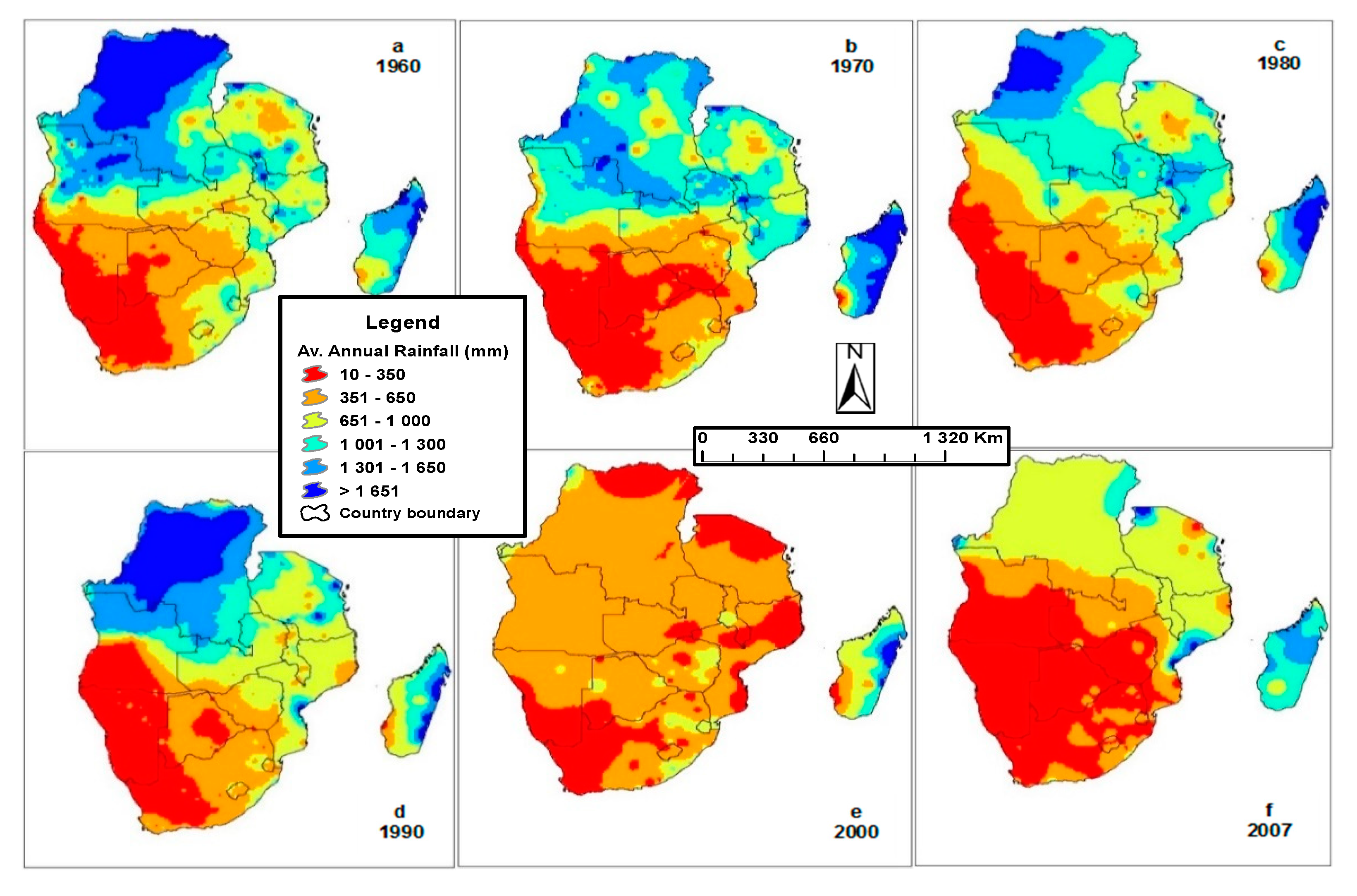


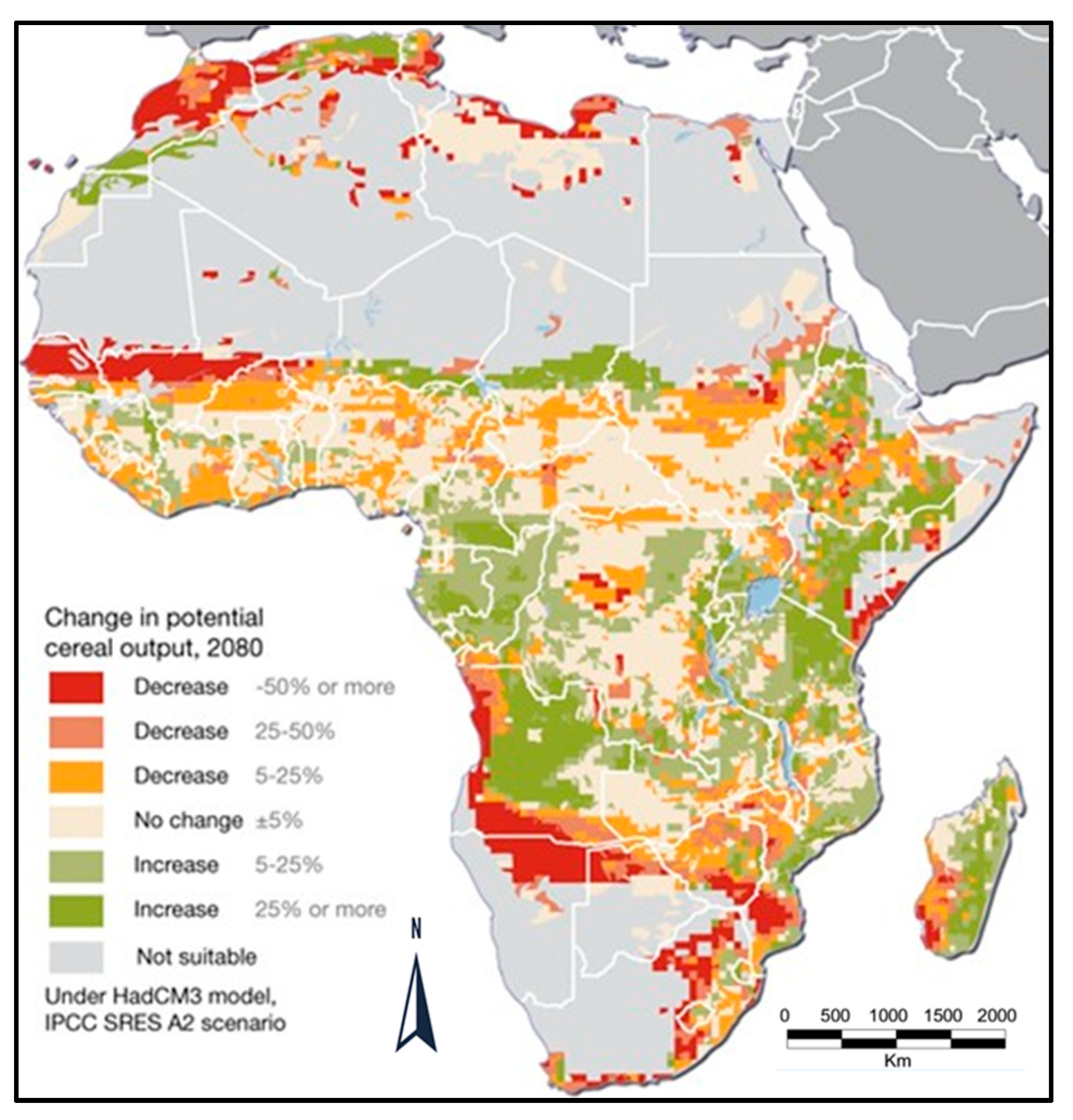
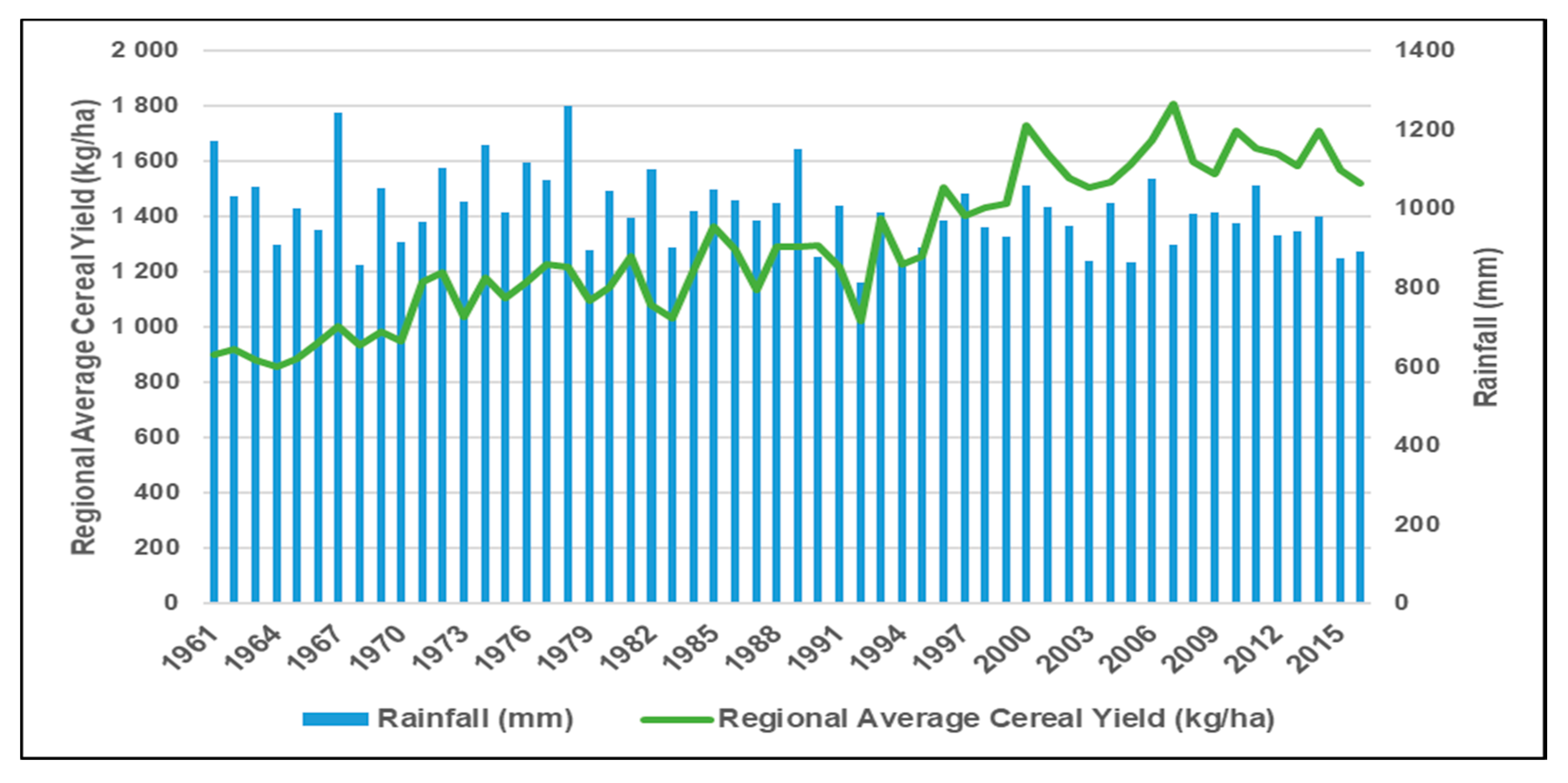
| Agricultural System | Area (km2) |
|---|---|
| Irrigated area | 93,658.61 |
| Rainfed area | 744,665.78 |
| Water managed area (non-irrigated) | 227,467.44 |
| Total cultivated area | 1,065,791.84 |
| Country | Area Weighted Average Annual Rainfall (mm) | Percentage Change | |||||||||
|---|---|---|---|---|---|---|---|---|---|---|---|
| 1960 | 1970 | 1980 | 1990 | 2000 | 2007 | 1960–1970 | 1960–1980 | 1960–1990 | 1960−2000 | 1960−2007 | |
| Angola | 1088.9 | 940.5 | 696.1 | 751.09 | 576.2 | 766.3 | −13.6 | −36.1 | −31.0 | −47.1 | −29.6 |
| Botswana | 418.5 | 300.8 | 459.5 | 349.19 | 510.9 | 252.2 | −28.1 | 9.8 | −16.6 | 22.1 | −39.7 |
| Congo DR | 1473.8 | 1268.4 | 1224.0 | 1427.79 | 477.6 | 932.7 | −13.9 | −16.9 | −3.1 | −67.6 | −36.7 |
| Lesotho | 807.7 | 548.5 | 487.8 | 576.11 | 547.5 | 381.7 | −32.1 | −39.6 | −28.7 | −32.2 | −52.7 |
| Madagascar | 1335.8 | 1585.5 | 1428.5 | 1158.60 | 988.2 | 1228.6 | 18.7 | 6.9 | −13.3 | −26.0 | −8.0 |
| Malawi | 1062.4 | 1154.5 | 1172.0 | 752.70 | 346.2 | 920.0 | 8.7 | 10.3 | −29.1 | −67.4 | −13.4 |
| Mauritius | 1669.5 | 1734.0 | 2505.0 | 1203.00 | 1270.3 | 1495.7 | 3.9 | 50.0 | −27.9 | −23.9 | −10.4 |
| Mozambique | 933.4 | 847.1 | 915.9 | 792.00 | 445.3 | 554.2 | −9.3 | −1.9 | −15.2 | −52.3 | −40.6 |
| Namibia | 263.1 | 212.9 | 261.2 | 145.36 | 360.6 | 141.6 | −19.1 | −0.7 | −44.7 | 37.1 | −46.2 |
| Seychelles | 1880.0 | 1977.0 | 1780.0 | 2048.00 | 1390.7 | 1979.0 | 5.2 | −5.3 | 8.9 | −26.0 | 5.3 |
| South Africa | 532.6 | 437.8 | 467.9 | 449.83 | 435.0 | 324.9 | −17.8 | −12.1 | −15.5 | −18.3 | −39.0 |
| Swaziland | 1004.3 | 612.7 | 872.7 | 630.87 | 704.2 | 367.9 | −39.0 | −13.1 | −37.2 | −29.9 | −63.4 |
| Tanzania | 1004.3 | 1058.7 | 963.1 | 1010.65 | 414.9 | 873.8 | 5.4 | −4.1 | 0.6 | −58.7 | −13.0 |
| Zambia | 921.5 | 910.5 | 949.5 | 835.26 | 460.7 | 491.5 | −1.2 | 3.0 | −9.4 | −50.0 | −46.7 |
| Zimbabwe | 650.8 | 489.8 | 711.5 | 658.05 | 507.5 | 283.7 | −24.7 | 9.3 | 1.1 | −22.0 | −56.4 |
| SADC av. | 1203.2 | 998.0 | 1001.2 | 961.6 | 731.2 | 895.3 | −17.1 | −16.8 | −20.1 | −39.2 | −25.6 |
| Mean | 1003.11 | 938.56 | 992.99 | 852.57 | 629.05 | 732.91 | - | - | - | - | - |
| Standard dev. | 450.45 | 531.35 | 580.77 | 470.92 | 325.66 | 519.06 | - | - | - | - | - |
| Coefficient var | 0.45 | 0.57 | 0.58 | 0.55 | 0.52 | 0.71 | - | - | - | - | - |
© 2020 by the authors. Licensee MDPI, Basel, Switzerland. This article is an open access article distributed under the terms and conditions of the Creative Commons Attribution (CC BY) license (http://creativecommons.org/licenses/by/4.0/).
Share and Cite
Nhemachena, C.; Nhamo, L.; Matchaya, G.; Nhemachena, C.R.; Muchara, B.; Karuaihe, S.T.; Mpandeli, S. Climate Change Impacts on Water and Agriculture Sectors in Southern Africa: Threats and Opportunities for Sustainable Development. Water 2020, 12, 2673. https://doi.org/10.3390/w12102673
Nhemachena C, Nhamo L, Matchaya G, Nhemachena CR, Muchara B, Karuaihe ST, Mpandeli S. Climate Change Impacts on Water and Agriculture Sectors in Southern Africa: Threats and Opportunities for Sustainable Development. Water. 2020; 12(10):2673. https://doi.org/10.3390/w12102673
Chicago/Turabian StyleNhemachena, Charles, Luxon Nhamo, Greenwell Matchaya, Charity R. Nhemachena, Binganidzo Muchara, Selma T. Karuaihe, and Sylvester Mpandeli. 2020. "Climate Change Impacts on Water and Agriculture Sectors in Southern Africa: Threats and Opportunities for Sustainable Development" Water 12, no. 10: 2673. https://doi.org/10.3390/w12102673
APA StyleNhemachena, C., Nhamo, L., Matchaya, G., Nhemachena, C. R., Muchara, B., Karuaihe, S. T., & Mpandeli, S. (2020). Climate Change Impacts on Water and Agriculture Sectors in Southern Africa: Threats and Opportunities for Sustainable Development. Water, 12(10), 2673. https://doi.org/10.3390/w12102673







